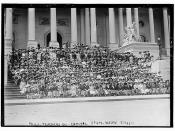This paper will discuss Chapter 5 and the continuum of strategies using the SIOP model and the appropriate situations to use each within the classroom. It will also discuss when these strategies may be used inappropriately in the classroom. In research literature, learning strategies of three types have been identified, which are cognitive strategies, meta-cognitive strategies, and social/affective strategies. Cognitive strategies assist students in organizing information through learning that is self-regulated. Meta-cognitive strategies use awareness, interaction, and reflection in a manner that is interrelated, integrated, and recursive. Social/Affective Strategies are affective and social influences on learning. Enhanced learning is possible when people interact with each other to clarify their doubts or when they involve themselves in group related activities to solve a problem (Echevarria et al, 2000). During the process of teaching learning, a continuum of strategies occurs from teacher-centered, teacher-assisted, peer-assisted, and student-centered. Through practice with student-centered and peer-assisted strategies, students' ultimate goal is to develop independence in self-regulation and self-monitoring.
However, difficulties are faced by several English learners in initiating an active role in using these strategies. This happens because English learners are required to focus their mental energy on language skills development. It is therefore important that sheltered instruction teachers scaffold English learners by providing them with numerous opportunities to use a wide range of proven, effective strategies (Echevarria et al, 2000).Consider a common sheltered instruction classroom scenario, where a topic is being taught by a teacher. For example, assume that the topic is conservation and preservation of terrestrial resources. A teacher could model and teach several important processing strategies by engaging students in the SQP2RS/Squeepers activity for the expository text selection that include evaluation, self-questioning, prediction, monitoring and clarifying, and summarizing. A teacher could then lead students through the modeled activity, providing support for surveying text,


